• Scientists have classifi ed the organism in different kingdoms at different times. Biological classifi cation was fi rst proposed by Aristotle who used simple morphological characters to classify plants and animals.
• Linnaeus initially separated plants and animals in two kingdoms i.e., Kingdom Plantae and Kingdom Animalia. Until recently, it was universally accepted. But later it was found that two-kingdom classifi cation was not sufficient for the following reasons :
(i) Prokaryotes and eukaryotes have been grouped together.
e.g., Bacteria and Cyanobacteria were placed under plant kingdom.
(ii) Heterotrophs and autotrophs were placed together.
e.g., Fungi, which are heterotrophs were placed with plants.
Euglena, has chlorophyll was placed under protozoa, which are heterotrophs.
(iii) It did not differentiate between unicellular and multicellular organisms.
e.g., Protozoans are unicellular organisms, but were placed with multicellular animals.
(iv) Simple organisms were placed with highly complex organisms.
e.g., Protozoans were placed with human beings in animal kingdom.
Bacteria (prokaryotes) were placed with highly evolved angiosperms in plant kingdom.
(v) Unicellular aquatic organisms are diffi cult to distinguished as plants and animals.
• In three kingdom system, kingdom protista was included along with kingdom plantae and kingdom animalia.
• Three kingdom classifi cation was given by Haeckel. They placed all unicellular eukaryotes in protista whether they were plants or animals.
• This system was not accepted because it includes both prokaryotic and eukaryotic, chlorophyllous and non-chlorophyllous organisms together.
• Copeland classified organisms into four kingdoms; Monera (all prokaryotes), Protista (unicellular eukaryotes), Metaphyta (multicellular plants) and Metazoa (multicellular eukaryotes).
• Most accepted system of classifi cation is five kingdoms classifi cation which was given by Whittaker.
Characteristics of five kingdom system
This system was proposed by R.H. Whittaker (1969). Accordingly a separate kingdom has been created for Fungi. Thus, these are – Monera, Protista, Fungi, Plantae and Animalia. The five kingdom classifi cation is based on the following criteria :
• Complexity of cell structure – Prokaryotes or Eukaryotes
• Complexity of organisms body – Unicellular or Multicellular
• Mode of obtaining nutrition – Autotrophs or Heterotrophs
• Phylogenetic relationships
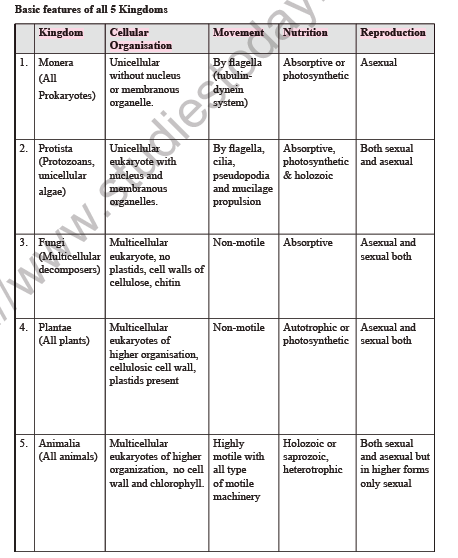
Biological classification
Biological classification is defined as the process of grouping the organisms according to certain similarities
Linnaeus proposed the two kingdoms of classification. He classified organism into animal kingdom as Animalia and plant kingdom as Plantae. There were certain limitations associated with two kingdom classification such as- it does not differentiate between eukaryotes and prokaryotes, unicellular and multicellular organisms, and photosynthetic and non-photosynthetic organisms.
Five kingdom classifications
R.H. Whittaker proposed the five kingdoms of classification. The five kingdoms classification is as follows- Monera, Protista, Fungi, Plantae, and Animalia. The classification was based on thallus organization, cell structure, mode of nutrition, phylogenetic relationship, and reproduction.
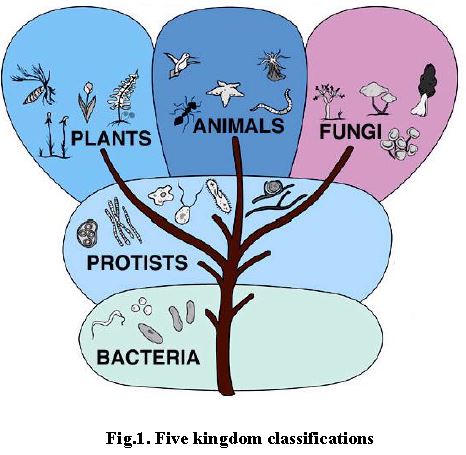
Kingdom Monera
The most important members of Monera are Bacteria. All organisms present in this kingdom are prokaryotes. It includes bacteria as well as blue-green algae. They can be present in extreme habitats such as hot springs, deserts, snow as well as deep oceans. Certain organisms act as parasites also. All monerans are prokaryotes. They do not have the true nucleus, that is, nucleus not surrounded by nuclear membrane. They can be autotrophs, heterotrophs as well as parasites. They do have cell wall. There respiration can be aerobic as well as anaerobic. The movement occurs through flagella. Exchange of nutrients or gases occurs by diffusion.
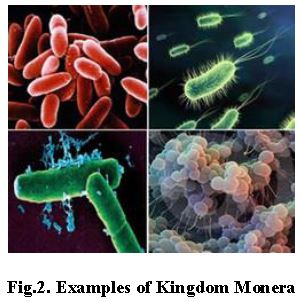
They are divided into Archaebacteria and Eubacteria.
Archaebacteria
Archaebacteria can be thermoacidophiles (hot springs), halophiles (survive in high salt concentration), and methanogens (marshy areas). There structure of cell wall is different from other monerans. Methanogens are found in the gut of some ruminants such as buffaloes and cows. This helps in production of biogas from the dung of the animal.
Eubacteria
They are referred as “True bacteria”. The presence of motile flagellum and a rigid cell wall characterize them. It includes cyanobacteria (blue-green algae). They are like plants in having chlorophyll a. So, known as photosynthetic autotrophs.
Cyanobacteria are unicellular, filamentous algae. They form colonies which are surrounded by gelatinous sheath. Some have specialized structures known as heterocyst which helps in fixing nitrogen. For example, Nostoc.
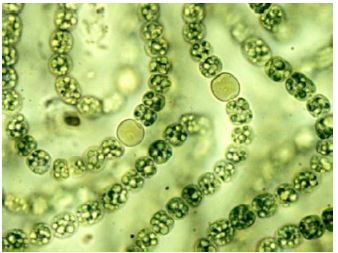
Fig.3. Nostoc
There are certain bacteria that can oxidize certain inorganic substances such as nitrites, nitrates, they are known as chemosynthetic autotrophs. The energy released during oxidation is used in the production of the ATP.
Bacteria can reproduce asexually by fission. They can also reproduce through spores under unfavorable conditions. Monera also includes Mycoplasma. They do not have cell wall and survive in anaerobic conditions. Mycoplasma are the smallest living organisms known.
Kingdom Protista
Single celled eukaryotes are kept under Protista. They are mostly aquatic in nature. For example, Algae serves as primary producers in aquatic ecosystem. They are unicellular, eukaryotic organisms. They have true nucleus, bounded by nuclear membrane. They can move by cilia as well as via flagella. Respiration can be both aerobic as well as anaerobic. Similarly, reproduction can be sexual as well as asexual.
They are divided into Chrysophytes, Dinoflagellates, Euglenoids, Slime moulds and Protozoans.
1. Chrysophytes
It consists of diatoms and golden algae. They can live in freshwater water as well as marine water. Mostly they are photosynthetic. Their cell wall is impregnated with silica. They are the major producers in the oceans. Mostly they are unicellular flagellates. But some are amoeboid.
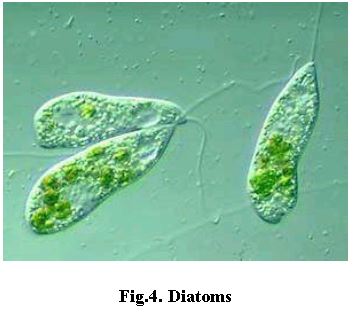
2. Dinoflagellates
Dinoflagellates are marine and photosynthetic organisms. They can be of different colors such as yellow, brown, red, or blue in color. The color is due to the presence of different colored pigments present in the cells of the dinoflagellates. The cell wall is made up of cellulose. They are biflagellate with one flagella placed longitudinally and other flagella placed transversely. For example, Gonyaulax catenella, Noctiluca scintillans.
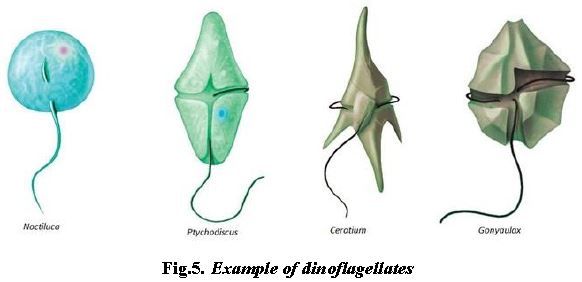
3. Euglenoids
Euglenoids are freshwater organisms that are found in stagnant water. They are surrounded by a protein rich layer known as pellicle. They have one short flagella and one long flagella. They can behave as autotrophic as well as heterotrophic organisms. For example, Euglena.
Most of the euglenoids have chloroplast so they can synthesize their own food. The reserve food material found is euglenoids are Paramylon (carbohydrate).
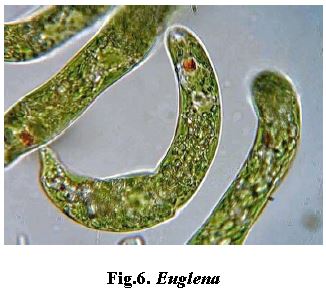
4. Slime moulds
They are saprophytic in nature. Under favorable conditions, they form aggregates which are known as Plasmodium. During unfavorable condition, they form fruiting bodies with spores. They possess true cell walls. They are extremely resistant to adverse conditions.
5. Protozoan like protists
They are heterotrophs. They can live as predators as well as parasites. There are four major types of protozoans found-
• Amoeboid protozoans are found in fresh water, moist soil, or sea water. They possess pseudopodia for engulfing the food particles, such as Amoeba.
• Flagellated protozoans can be free-living or parasitic. This group of organisms are responsible for different parasitic diseases. For example, Trypanosoma causes sleeping sickness.
• Ciliated protozoans possess thousands of cilia. The movement of cilia helps in propelling forward or backward. It also helps in obtaining food from the outside. For example, Paramecium.
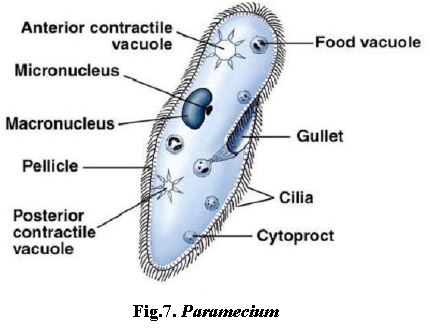
• Sporozoans form reproductive cells which are known as spores. They are parasitic and pathogenic in nature. For example, Plasmodium species causes Malaria. Reproduction can be asexual or sexual.

Kingdom Fungi
Fungi are heterotrophic in nature. Some acts on dead organic matter and so known as saprophytes. Some can feed on living organisms so known as parasites. Some fungi can live in mutual relationship with other organisms such as algae, they are known as lichens. Such fungi are known as symbionts. Lichens are symbiotic association between the fungi and the algae. Mycorrhiza are the symbiotic association between the fungi and the roots of the higher plants.
Reproduction in fungi can occur by- budding, fragmentation, and fission. Asexual reproduction occurs by means of spores known as conidia, zoospores or sporangiospores.
Sexual reproduction occurs by oospores, ascospores and basidiospores. There are three steps of sexual cycle in fungi-the first step is the fusion of the protoplasm which is known as plasmogamy. Then, the fusion of nuclei occurs which is known as karyogamy. This results in the formation of the zygote. Then finally, the meiosis of zygote results in the formation of the spores.
The vegetative part of the fungus is known as mycelium. The network of hyphae is known as mycelium. During sexual cycle of fungi, two haploid hyphae fuses to form diploid cells. Kingdom fungi is divided into different classes-
• Phycomycetes (lower fungi)- Asexual reproduction occurs by motile spores known as zoospores and non-motile spores are known as aplanospores. Spores are produced inside the sporangium. Fusion of gametes give rise to zygospore. Mycelium is coenocytic (multiple nucleus) and multicellular. For example, such as Mucor, Rhizopus, Albugo.
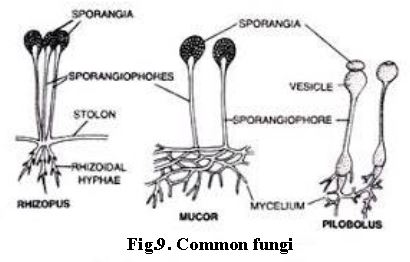
• Ascomycetes (sac fungi)- They can be saprophytic as well as parasitic. Asexual reproduction occurs by conidia. Sexual reproduction occurs through ascospores. Branched and septate mycelium is found in Ascomycetes. For example, Penicillium, Aspergillus, Claviceps etc.
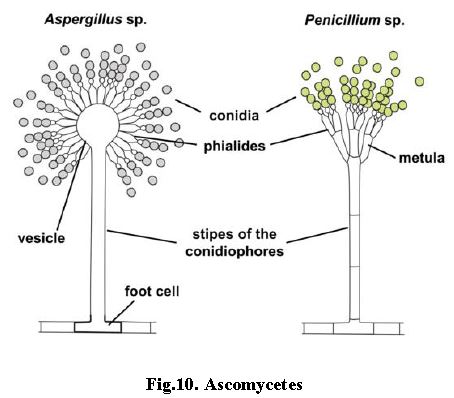
• Basidiomycetes (club fungi)- Vegetative reproduction occurs through fragmentation. Absence of sex organs. Plasmogamy between two vegetative or somatic cells results in the formation of basidium. Basidium undergo karyogamy and meiosis to form four basidiospores. For example, Agaricus (mushrooms), Ustilago (smut) etc.
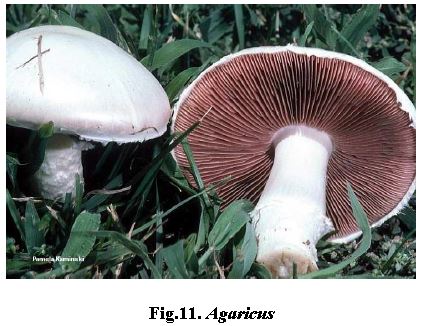
• Deuteromycetes are commonly known as imperfect fungi as they do not have sexual reproduction at any stage of the life. The asexual reproduction occurs by conidia. Mycelium is septate and branched. For example, Alternaria, Trichoderma etc.
• Zygomycetes (conjugation fungi) are primitive group of fungi. Asexual reproduction occurs by non-motile sporangiospores. For example, Rhizopus.
Kingdom Plantae
It includes all photosynthetic, multicellular, eukaryotic plants. Characteristics of members of Plantae are as follows-
• Mostly they are eukaryotic in nature.
• The main pigment present is chlorophyll.
• Their cell wall is made up of cellulose.
• Photosynthesis helps in the synthesis of the food.
• Reproduction can be sexual as well as asexual.
• They exhibit the phenomenon of alternation of generation, that is, diploid sporophyte and haploid gametophyte.
Kingdom Animalia
They are heterotrophic, eukaryotic organisms. Some of the characteristics of members of Animalia are as follows-
• They are multicellular organisms with variable size.
• They have well developed organ system such as skeleton system, circulatory system, respiratory system etc
• They are bilaterally symmetrical.
• They have well developed locomotory organs.
• Respiration occurs by gills, book lungs, book gills, skin, lungs etc.
• Membrane bound cell organelles with nucleus bounded by a nuclear membrane.
• Circulation occurs via blood, blood vessels, and heart.
• Reproduction occurs by the formation of the haploid gametes. The fusion of gametes give rise to a new diploid organism.
• Kidneys are the main respiratory organs.
Viruses:
They are acellular structures and therefore do not find a place in Whittaker’s five kingdom classification. They consist of a nucleic acid (either DNA or RNA) that is surrounded by a protein coat. They can grow and multiply only inside a host cell. Outside the host cell the viruses exist as crystals. They cause diseases and damage to the host. Examples of common viruses are the viruses causing common cod, influenza, polio, AIDS, etc.
Viroids:
They are the smallest structures known that are capable of infection. They consist only the nucleic acid without the protein coat.
Lichens:
They are symbiotic associations of algae and fungi. The algal partner is autotrophic and synthesizes and provides food. The fungal partner offers protection and shelter.

